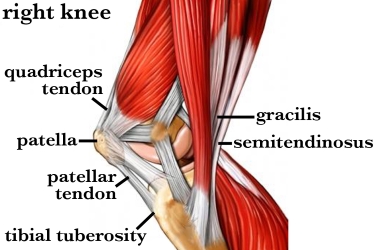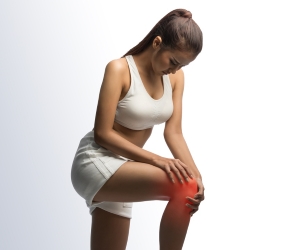Knee pain can be an annoyance which interferes with playing sports or doing strenuous activity. Or it can be a constant pain that makes climbing the stairs or just walking an everyday problem. Sometimes even sitting in the same position for too long can become uncomfortable. There are numerous causes of knee pain and most of them can be treated without the need for surgery.
Table Of Contents
What Causes Knee Pain
Many people who get knee pain assume that it’s wear and tear of cartilage. This a tissue that covers the surface of joints to prevent them rubbing against each other. Or they think it’s just something that comes with getting old, such as arthritis. But there are other causes that can be due to the ligaments around the knee, or muscles that initially don’t seem to have anything to do with it.
Knee Pain From Ligaments

Between the bones of your upper and lower leg there is cartilage to prevent them from rubbing against each other. This means the joint has to be held in place by ligaments. There are 4 main ones. The anterior and posterior cruciate ligaments, and the medial and lateral collateral ligaments. Injuries can occur from over-extension, such as turning sharply playing sport. If this causes a major tear, surgery may well be necessary, but if less severe it can recover naturally. However, the build up of scar tissue around the injury can lead to knee pain.
How Massage Can Help
A damaged ligament should be rested and iced for the next 72 hours. After this, a minor injury can then be massaged to help promote healing and prevent the formation of scar tissue. For more serious injuries it is recommended you wait a week. If the injury is older then knee pain could well be from scar tissue that has formed, even if it is weeks or months old. Massage to the affected area can still be a benefit.
Knee Pain From Muscles

Knee pain from your muscles is more common than from ligaments and often without there being an injury. The muscles of your thigh, such as the quadriceps, connect to the patella (knee cap). Other muscles, such as the sartorius, extend past it to the tibia (shin). Also the muscles at the back of your thigh, such as the hamstring, run behind the knee to the lower leg. Tension in your muscles can be caused by injury, scar tissue, heavy use such as regular running or weight training. Or it could just be lack of flexibility. This can shorten and tighten your muscles, which is often the cause of knee pain.
How Massage Can Help
If your knee pain is to do with tight muscles then a massage will help to loosen them up. It will also improve flexibility and prevent injuries in the future. As a rough guide, if the pain is at the front of your knee it is your thigh muscles that need attention, if it is on the inside it could be your sartorius or hamstrings. Pain at the back of your knee could also be your hamstrings, or it might be your calf muscles which extend up to the thigh. While pain on the outside of your knee is often due to a tight IT band.
Any pain should initially be checked by your doctor. This is especially important if it is severe, came on suddenly or there is any swelling. Once anything serious has been ruled out, a massage therapist can help speed up recovery from injury or relax tight muscles to treat or even prevent knee pain.
Knee Pain From Arthritis
Arthritis in the knee can be a debilitating condition that causes pain, stiffness, swelling and clicking or grating. It is often worse first thing on a morning or after other periods of inactivity, but too much weight-bearing work can also aggravate symptoms. Although it is degenerative condition that can require surgery, studies have shown that massage can provide many benefits(1).
How Massage Can Help
If your arthritis is severe enough to reduce your activity level, this can in turn make the associated pain and stiffness worse. Massage can increase blood flow to the knee joint which helps to cleanse the area of toxins and debris. As well as this, receiving freshly oxygenated blood helps the process of repairing the cartilage.
Pain and stiffness in general has long been shown to be reduced by massage. By over-riding the pain sensation while releasing feel-good endorphins, movement and activity levels are likely to increase. In turn this helps to improve the flexibility of muscle, tendons and ligaments around the knee already which are already directly benefiting from massage.
Book A Mobile Massage
If you would like to book a mobile massage in York please contact me on 07713 250352 or email david@massageinyork.co.uk. Includes sports massage, deep tissue massage and Swedish massage. For more information on booking click here
